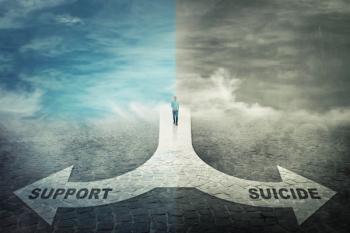
Looking Within: The Inside Problem of Racism in Psychiatry
Racism is a problem that exists in our space. A new advocacy moment is here, and it needs to be seized.
COMMENTARY
The sight was familiar: 2 law enforcement officers escorting a middle-aged Black man through the doors of the emergency department.
“Emotionally Disturbed. Found in Grand Central. Acting erratic. Name’s Jones.”
The attending glanced at the patient, nodded, signed the police form. As we returned to our workstations, I observed him writing a brief triage note and placing a diagnosis in the chart—Erratic, disheveled, psychotic. African American male. Schizophrenia.
Psychotic? I glanced back to see what I had missed.
Hours later, having slowly chipped away at our ever- growing list, it was time for “Mr Jones”* to be seen. I opened his chart and discovered that he had been brought into the Emergency Department (ED) by police before, always from Grand Central Station and always late at night. He was homeless and supported himself by panhandling. The psychiatric assessments consistently described him as logical, coherent, and intelligent. He was discharged immediately after each evaluation. Anger began to swell in my gut—why was this man without a psychiatric illness repeatedly brought to the ED by police?
A pleasant interview with Mr Jones confirmed the history and assessment in his chart. He was frustrated that police routinely took him to the hospital where he would be placed in a locked unit only to be discharged immediately after evaluation. I apologized. I found clean clothes and sandwiches for him and rushed to find the nearest attending to approve his discharge.
By the time Mr Jones had left the department, my anger had reached a full boiling rage. Had a senior psychiatrist in a renowned psychiatric department eyeballed a patient and concluded that he was psychotic, based only on his appearance and the circumstances under which he was brought to the hospital?
As a psychiatrist it is impossible for me to imagine practicing medicine without concurrent engagement in advocacy. After all, I would not shovel my walk while a blizzard was still raging. The pressing problems faced by our patients are almost invariably tied to large structural problems that must be addressed through legislative reform and community level interventions. They are also problems that disproportionately affect people of color. I could provide psychotherapy to my patient, who is newly homeless and grieving the loss of her partner to a drug overdose, but that is not much of a cure. I can prescribe a selective serotonin reuptake inhibitor to the gentleman who meets DSM-V criteria for general anxiety disorder, but will it truly help quell his anxiety as he navigates his racially hostile work environment—the place where his anxiety is worst?
Thankfully, I am far from unique in my thinking. My residency program has advocacy embedded in the curriculum. Many of my peers interact regularly with their government representatives and draft bills and testify before the legislature. Both the American Psychiatric Association (APA) and the American Medical Association (AMA) espouse advocacy as a core value in medicine, going so far as to provide guidance for physicians to become involved in legislative efforts. I celebrate this attention to advocacy. And yet it is also clear that we have ignored the very important work that needs to be done in our own home.
Mr Jones was brought to the psychiatric ED because of structural problems that include racism, poverty, unemployment. We might be tempted to externalize these problems, to see them as existing in spaces that are not our own. But Mr Jones was assumed to have a psychotic disorder because that same racism pervades our psychiatric spaces too. The attending’s misdiagnosis of Mr Jones was not an isolated incident, but rather a reflection of a broader issue in psychiatry. Racism is an inside problem for us in medicine. Focusing our efforts on only the former is tantamount to shoveling half the sidewalk in the middle of a blizzard.
Black males are incarcerated at greater than 5 times the rate of white males in the United States1 with evidence that differential treatment of black people in the legal system is an important factor.2 My anecdotal experience suggests that they also might be more likely to be brought to the hospital against their will for psychiatric evaluation. Equally distressing is that black males are more likely to be misdiagnosed with schizophrenia relative to their white peers who present with similar symptoms. The harms caused by each of these problems is severe. And with Mr Jones, the harms of each of these systems were compounded to perpetuate maximal injustice and harm.
While community and legislative advocacy have become more mainstream in medicine, change within our own institutions has been stagnant. With current motivation and energy focused on making anti-racist changes, the time has come for us to turn our focus to ourselves, to fix the problems in our own house. This is especially true for white psychiatrists like me. A new advocacy moment is here. We must seize it.
It took a full week for me to have the schizophrenia diagnosis scraped from Mr Jones’ chart. Yet having it removed hardly felt like a victory. Would it happen to him again? How many other black male patients have a psychotic diagnosis inappropriately listed in their charts? And perhaps most distressing to me—for how many of those might I be responsible?
*The patient’s name and identifying information in this essay have been changed to protect confidentiality.
Dr Danzig is a fourth-year resident in psychiatry. She completed her internship in NYC before transferring to Yale where she is currently completing her training.
References
1. Garland B, Sophn C, Wodahl E. Racial disproportionality in the American prison population: Using the Blumstein method to address the critical race and justice issues of the 21st Century. Justice Policy Journal. 2008;5(2):1-42.
2. Bridges G, Crutchfield RD. Law, social standing and racial disparities in imprisonment. Social Forces. 1982;66(3):699-724.
Newsletter
Receive trusted psychiatric news, expert analysis, and clinical insights — subscribe today to support your practice and your patients.

















